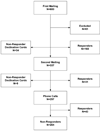Development and psychometric assessment of the collaborative care for attention-deficit disorders scale
- PMID: 18191777
- PMCID: PMC2245876
- DOI: 10.1016/j.ambp.2007.10.002
Development and psychometric assessment of the collaborative care for attention-deficit disorders scale
Abstract
Objective: To describe the development and assess the validity and reliability of the Collaborative Care for Attention-Deficit Disorders Scale (CCADDS), a measure of collaborative care processes for children with attention-deficit/hyperactivity disorder who attend primary care practices.
Methods: Collaborative care was conceptualized as a multidimensional construct. The 41-item CCADDS was developed from an existing instrument, review of the literature, focus groups, and an expert panel. The CCADDS was field tested in a national mail survey of 600 stratified and randomly selected practicing general pediatricians. Psychometric analysis included assessments of factor structure, construct validity, and internal consistency.
Results: The overall response rate was 51%. Most respondents were male (56%), 46 years old or older (59%), and white (69%). Common factor analysis identified 3 subscales: beliefs, collaborative activities, and connectedness. Internal consistency reliability (coefficient alpha) for the overall scale was .91, and subscale scores ranged from .80 to .89. The CCADDS correlated with a validated measure of provider psychosocial orientation (r = -.36, P < .001) and with self-reported frequency of mental health referrals or consultations (r = -.24 to -.42, P < .001). CCADDS scores were similar among physicians by race/ethnicity, gender, age group, and practice location.
Conclusions: Scores on the CCADDS were reliable for measuring collaborative care processes in this sample of primary care clinicians who provide treatment for children with attention-deficit/hyperactivity disorder. Evidence for validity of scores was limited. Future research is needed to confirm its psychometric properties and factor structure and provide guidance on score interpretation.
Similar articles
-
An evaluation of the psychometric properties of the Australian Collaborative Practice Assessment Tool.PLoS One. 2024 May 9;19(5):e0302834. doi: 10.1371/journal.pone.0302834. eCollection 2024. PLoS One. 2024. PMID: 38722882 Free PMC article.
-
A process for developing community consensus regarding the diagnosis and management of attention-deficit/hyperactivity disorder.Pediatrics. 2005 Jan;115(1):e97-104. doi: 10.1542/peds.2004-0953. Pediatrics. 2005. PMID: 15629972
-
Development of an instrument to measure parents' preferences and goals for the treatment of attention deficit-hyperactivity disorder.Acad Pediatr. 2012 Sep-Oct;12(5):445-55. doi: 10.1016/j.acap.2012.04.009. Epub 2012 Jun 28. Acad Pediatr. 2012. PMID: 22748759 Free PMC article.
-
Evaluation of Neuropsychiatric Function in Phenylketonuria: Psychometric Properties of the ADHD Rating Scale-IV and Adult ADHD Self-Report Scale Inattention Subscale in Phenylketonuria.Value Health. 2015 Jun;18(4):404-12. doi: 10.1016/j.jval.2015.01.008. Epub 2015 Apr 4. Value Health. 2015. PMID: 26091594 Clinical Trial.
-
[Psychometric characteristics of questionnaires designed to assess the knowledge, perceptions and practices of health care professionals with regards to alcoholic patients].Encephale. 2004 Sep-Oct;30(5):437-46. doi: 10.1016/s0013-7006(04)95458-9. Encephale. 2004. PMID: 15627048 Review. French.
Cited by
-
Strategies for addressing barriers to publishing pediatric quality improvement research.Pediatrics. 2011 Sep;128(3):e678-86. doi: 10.1542/peds.2010-0809. Epub 2011 Aug 15. Pediatrics. 2011. PMID: 21844057 Free PMC article.
-
Measurement Instruments for Integration within Children and Young People Healthcare Systems and Networks: A Rapid Review of the International Literature.Int J Integr Care. 2023 May 23;23(2):18. doi: 10.5334/ijic.7028. eCollection 2023 Apr-Jun. Int J Integr Care. 2023. PMID: 37250761 Free PMC article.
-
Survey of mental health consultation and referral among primary care pediatricians.Acad Pediatr. 2009 Mar-Apr;9(2):123-7. doi: 10.1016/j.acap.2008.12.008. Acad Pediatr. 2009. PMID: 19329104 Free PMC article.
References
-
- U.S. Public Health Service. Report of the Surgeon General's Conference on Children's Mental Health: a national action agenda. Washington, D.C.: 2000. - PubMed
-
- Anonymous. New Freedom Commission on Mental Health, achieving the promise: transforming mental health care in America. [Accessed May 1, 2006]. http://www.mentalhealthcommission.gov/
-
- Katon W, Von Korff M, Lin E, Simon G. Rethinking practitioner roles in chronic illness: the specialist, primary care physician, and the practice nurse. Gen Hosp Psychiatry. 2001;23:138–144. - PubMed
-
- American Academy of Pediatrics. Care coordination: integrating health and related systems of care for children with special health care needs. Pediatrics. 1999;104(4):978–981. - PubMed
-
- Greenbaum PE, Lipien L, Dedrick RF. An instrument to measure interagency collaboration among child-serving organizations. Paper presented at: American Psychological Association; Honolulu, HI. 2004.
Publication types
MeSH terms
Grants and funding
LinkOut - more resources
Full Text Sources
Medical


